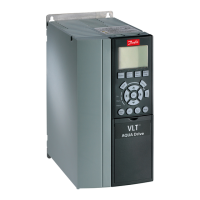•
•
•
•
•
•
•
•
•
•
•
Basic speed mode using the set speed and ramps.
Activates the homing function selected in parameter 17-80 Homing Function.
The drive controls the position based on cyclic position reference from an external controller.
Speed/ramp profile must be calculated/handled by the external controller.
The drive controls the speed based on cyclic speed reference from an external controller. Ac-
celeration/deceleration must be handled by the external controller.
The drive is synchronizing to the provided master positions using the set gear ratio.
The drive is synchronizing to the provided master positions according to the set Cam table.
5.2.2 Motor Setups
5.2.2.1 Asynchronous Motor Setup
Enter the following motor data. Find the information on the motor nameplate.
Parameter 1-20 Motor Power [kW] or parameter 1-21 Motor Power [HP].
Parameter 1-22 Motor Voltage.
Parameter 1-23 Motor Frequency.
Parameter 1-24 Motor Current.
Parameter 1-25 Motor Nominal Speed.
When running in flux control principle, or for optimum performance in VVC+ mode, extra motor data is required to set up the fol-
lowing parameters. Find the data in the motor datasheet (this data is typically not available on the motor nameplate). Run a com-
plete automatic motor adaptation (AMA) using parameter 1-29 Automatic Motor Adaptation (AMA) [1] Enable Complete AMA or enter
the parameters manually. Parameter 1-36 Iron Loss Resistance (Rfe) is always entered manually.
Parameter 1-30 Stator Resistance (Rs).
Parameter 1-31 Rotor Resistance (Rr).
Parameter 1-33 Stator Leakage Reactance (X1).
Parameter 1-34 Rotor Leakage Reactance (X2).
Parameter 1-35 Main Reactance (Xh).
Parameter 1-36 Iron Loss Resistance (Rfe).
Application-specific adjustment when running VVC+
VVC+ is the most robust control mode. In most situations, it provides optimum performance without further adjustments. Run a
complete AMA for best performance.
Application-specific adjustment when running flux
Flux control principle is the preferred control principle for optimum shaft performance in dynamic applications. Perform an AMA
since this control mode requires precise motor data. Depending on the application, further adjustments may be required.
Table 67: Recommendations for Flux Applications
Low-inertia applica-
tions
High-inertia appli-
cations
Parameter 1-66 Min. Current at Low Speed. Increase current to a value between default and maximum de-
pending on the application. Set ramp times matching the application. Too fast ramp up causes an over-
current or overtorque. Too fast ramp down causes an overvoltage trip.
AU275636650261en-000101 / 130R0334 | 69Danfoss A/S © 2022.12
Parameter Descriptions
VLT AutomationDrive FC 301/302
Programming Guide

